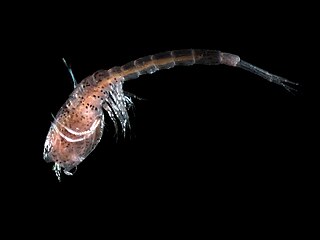| Iphinoe | |
|---|---|
 | |
| Iphinoe trispinosa | |
| Scientific classification | |
| Domain: | Eukaryota |
| Kingdom: | Animalia |
| Phylum: | Arthropoda |
| Class: | Malacostraca |
| Superorder: | Peracarida |
| Order: | Cumacea |
| Family: | Bodotriidae |
| Subfamily: | Bodotriinae |
| Genus: | Iphinoe Bate, 1856 [1] |
| Type species | |
| Cuma trispinosa Goodsir, 1843 [2] | |
Iphinoe is a genus of crustaceans which belong to the family Bodotriidae. [1] It includes the following species: [3]
- Iphinoe acutirostris Ledoyer, 1965
- Iphinoe adriatica Băcescu, 1988
- Iphinoe africana Zimmer, 1908
- Iphinoe armata Ledoyer, 1965
- Iphinoe brevipes Hansen, 1895
- Iphinoe calmani Fage, 1945
- Iphinoe canariensis Corbera, Brito & Nunez, 2002
- Iphinoe capensis (Zimmer, 1921)
- Iphinoe coronata Gould, 1861
- Iphinoe crassipes Hansen, 1895
- Iphinoe dayi Jones, 1960
- Iphinoe douniae Ledoyer, 1965
- Iphinoe elisae Băcescu, 1950
- Iphinoe fagei Jones, 1955
- Iphinoe gurjanovae Lomakina, 1960
- Iphinoe hupferi Zimmer, 1916
- Iphinoe inermis Sars, 1878
- Iphinoe insolita Petrescu, 1992
- Iphinoe ischnura Zimmer, 1952
- Iphinoe kroyeri Philippi, 1849
- Iphinoe maculata Ledoyer, 1965
- Iphinoe maeotica Sowinskyi, 1893
- Iphinoe marisrubrae Muhlenhardt-Siegel, 1996
- Iphinoe pellucida Hale, 1944
- Iphinoe pigmenta Kurian, 1961
- Iphinoe plicata Le Loeuff & Intes, 1972
- Iphinoe pokoui Le Loeuff & Intes, 1972
- Iphinoe producta Day, 1978
- Iphinoe rhodaniensis Ledoyer, 1965
- Iphinoe robusta Hansen, 1895
- Iphinoe sagamiensis Gamo, 1958
- Iphinoe sanguinea Kemp, 1916
- Iphinoe senegalensis Jones, 1956
- Iphinoe serrata Norman, 1867
- Iphinoe solida Aurivillius, 1885
- Iphinoe stebbingi Jones, 1956
- Iphinoe tenella Sars, 1878
- Iphinoe tenera Lomakina, 1960
- Iphinoe trispinosa (Goodsir, 1843)
- Iphinoe truncata Hale, 1953
- Iphinoe zimmeri Stebbing, 1910










